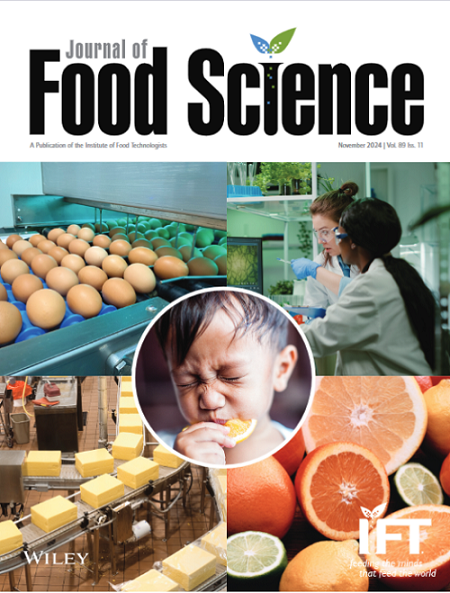Efficacy of sodium hypochlorite and peracetic acid in reducing cross-contamination during washing of baby spinach at different water quality levels
Abstract
We evaluated the antimicrobial performance of sodium hypochlorite (NaOCl) and peracetic acid (PAA) during washing of baby spinach in water of varying levels of organic load, as measured by its chemical oxygen demand (COD). Escherichia coli TVS353 was spot inoculated onto one unwashed leaf. Sanitizers were added into water with preadjusted COD (300 or 2500 ppm) to achieve concentrations from 20 to 80 ppm. One inoculated leaf was washed with nine uninoculated leaves in 500 mL water (n = 6). Bacterial load on inoculated leaves was lowered by sanitizers in a dose-dependent manner (p < 0.05) and the lowest bacterial survivor levels were observed at 80 ppm with 2.7 ± 1.2 and 5.1 ± 0.5 Log MPN/leaf for PAA and NaOCl, respectively, at low CODs. PAA was more effective in reducing bacterial load from the inoculated leaf than NaOCl at high CODs (p < 0.05), with 2.9 ± 2.8 and 5.3 ± 0.8 Log MPN/leaf survivors for PAA and NaOCl, respectively. At 80 ppm sanitizer levels, the bacteria was not detected in wash water at any condition but was detected at 20 and 40 ppm at high CODs. The lowest levels of bacteria transferred to uninoculated leaves were observed at 80 ppm sanitizer, at 0.3 ± 0.2 and 0.2 ± 0.1 Log MPN/leaf for PAA and 1.1 ± 1.0 and 0.3 ± 0.3 Log MPN/leaf for NaOCl at low and high CODs, respectively. The log percentage of bacteria transferred ranged from −1.1 at 0 ppm to over −4.5 at 80 ppm, highlighting a reduction in cross-contamination by the sanitizers.
Practical Application
This study provides effective data on sanitizer usage to fresh produce industry for ensuring food safety during washing of produce. It evaluated the sanitizer effect in a broad range of scenarios including various sanitizer concentrations, and wash water with low and high organic load that is common when recirculating wash water. The results also revealed the differences in two common sanitizers (PAA and NaOCl) in terms of their effectiveness.


 求助内容:
求助内容: 应助结果提醒方式:
应助结果提醒方式:


